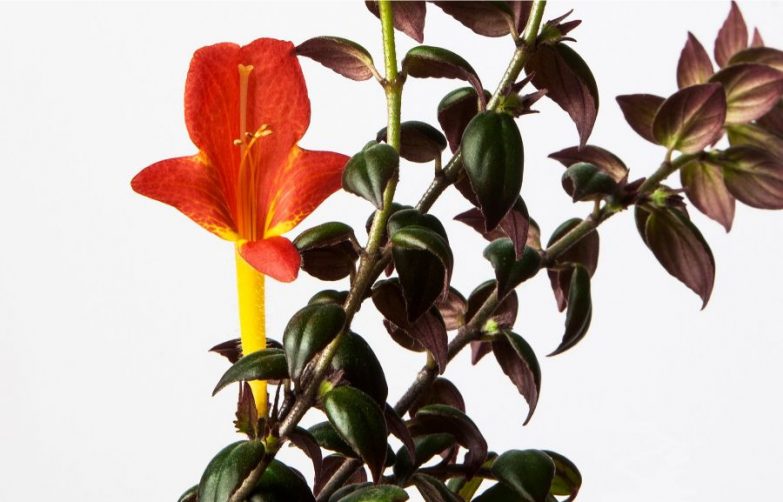The Goldfish plant (Columnea gloriosa) can start a conversation with anyone, kids included. It’s a showy tropical that sports intriguing and beautiful flowers that look rather like goldfish leaping through long stems of cascading leaves. Though its origins give it particular requirements, goldfish plant care isn’t difficult if you understand what it needs.
What is the right Goldfish plant care? The Columnea gloriosa loves warmth, but not high heat, long hours of bright light, and lots of moisture without being too wet. It needs fertilization to support its long blooming season, yet its small root system can’t absorb much at one time.
All of these needs are easily met indoors – you just need to know the tricks. Understanding the Goldfish plant’s native habitat helps unravel its mysteries. But once you know, you’ll find it’s an easy keeper indoors and remains almost constantly in bloom.
Overview Of The Goldfish Plant (Columnea Gloriosa)
A Goldfish plant in full bloom is a standout attraction, and even out of bloom, its trailing deep-green foliage lends an elegant and exotic accent to any space. The flowers pop out all along its stem, ranging in color from vibrant yellows to rich oranges and reds: the colors of its namesake.
Formally named Columnea gloriosa, this tropical epiphyte is native to Central and South America. It belongs to the gesneriad family and is commonly confused with the related Nematanthus and Aeschynanthus families. It’s also cousin to the African violet.
Being an epiphyte, the Goldfish plant takes in most of its moisture and food through its leaves – its roots are primarily for anchoring. The plant’s airborne nature and long, falling stems make it a great hanging plant for bright spaces.
It’s long-lived, too, surviving a decade or more with proper goldfish plant care. The mother plant can live indefinitely through its easily propagated stems.
Goldfish Plant Care Requirements
| Scientific Name | Columnea gloriosa |
| Origin | Central And South America |
| Light Requirements | 12 hours or more of bright, indirect light per day |
| Watering | Water once the top two inches of soil is dry. Needs consistent moisture, but take great care not to overwater due to delicate root system. |
| Soil | Extremely well draining potting mix. Equal parts peat, perlite and vermiculite works well. |
| Temperature | 65-75°F (18-24°C). They can survive short dips to the low 30s, but they are not frost tolerant. |
| Fertilizer | Mist every two weeks during the growing season with 1/4 strength, high phosphate, water soluble fertilizer. This is preferable to adding fertilizer to the soil. |
| Humidity | High humidity is essential. |
| Flowering | Rich red, yellow or orange blooms throughout the warm season with good care. |
| Pruning | Prune after flowering to promote compact growth. Cut vines back by half. |
| Propagation | Easily propagated by stem cutting, ideally in spring or summer. |
| Re-Potting | Prefers to be root bound, so only repot every few years. |
| Diseases and Pests | Damp conditions can promote fungal diseases. Aphids, mealybugs and scale are also attracted to goldfish plants. |
| Toxicity | Mildly toxic to humans and animals. |
Characteristics Of The Goldfish Plant
The Goldfish plant has oval-shaped dark green leaves arranged in pairs along woody stems that grow up to three feet long. Its draping foliage is attractive in its own right, but the elegantly leaping goldfish flowers are what makes it so memorable and fun.
The blooms may grow up to three inches long, and their colors are strikingly similar to actual goldfish. Some varieties look more like the famous aquatic pet than others and resemble a flying school leaping among the streams of leaves. It’s an easy plant to love and a favorite of children, too.
Goldfish Plant Care
The Columnea gloriosa evolved as a harmless lodger of neighboring trees, so it mainly survives through photosynthesis and needs long hours of bright light. The plant enjoys high humidity and prefers to be fertilized lightly, but frequently, through its leaves.
The potting soil should be very airy and light: it likes being moist, but also benefits from having its roots dry a bit between waterings. Many varieties cycle through short periods of dormancy, but don’t worry. They soon emerge with a new flurry of blooms.
A fairly fast grower in good conditions, Columnea gloriosas can add almost two feet of stem growth a year. It propagates easily, and with proper feeding and light can blossom from spring to late fall.
Light Requirements
The Goldfish plant needs bright indirect light, and plenty of it. Most of its energy comes from leaf-based photosynthesis instead of the roots: 12 or more hours of bright light per day are required for health, growth, and flowering.
A bright eastern exposure works well, or a northern exposure in warmer climates; they’ll need a little protection in a west-facing window. Save southern exposures for wintertime, and avoid direct sunlight which can scorch the leaves.
Fortunately, Columneas have affection for artificial lighting, so you can supplement natural light or replace it with another light source. Place the plant 18 inches from the light and observe its growth over time.
Because it’s more difficult to regulate light and temperature outside, it is usually best to keep the plant indoors year-round rather than move it outside for the warm season.
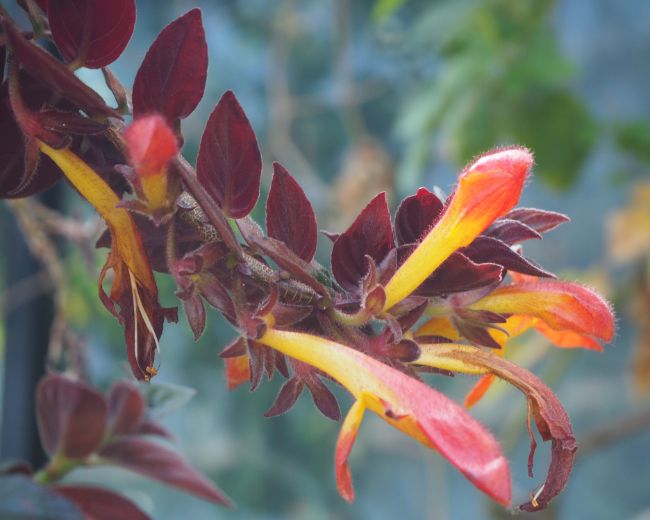
Goldfish Plant Soil
Before explaining how to water your Goldfish plant, let’s cover the planting medium. After inadequate light, improper potting soil is the most common mistake made with these epiphytes. Heavy soil is hard to overcome and often results in root rot or languishing plants that never bloom.
The goal is a mix that drains water straight through and leaves only a damp residue behind. A Columnea’s roots anchor the plant but absorb little water or nutrients; they quickly decay in soggy soil.
The potting mix you want is hardly soil at all. Even a light potting soil is too much. The best medium is equal parts of perlite, peat moss, and vermiculite. Don’t overdo the vermiculite: light as it is, it still holds more water than desirable. You can throw in some untreated wood chips if you have them.
A peat-based potting soil for African violets is okay with an addition of perlite. An orchid or succulent mix can work too.
Always use a sterile medium, because the Columnea’s weak roots succumb to soil-based pathogens that more robust root systems can take in their stride. Sterilize the mix if you’re not sure: bake it in the oven at 180° for a half hour. After your potting mix is sterile, store it in an airtight container so it stays that way.
Read more in this article about how to make the perfect potting soil for indoor plants.
Watering
The Goldfish plant needs consistent moisture, but it does best when the topsoil dries a bit between waterings. Wait until the top two inches of topsoil have dried. This helps prevent fungus and other problems.
PRO TIP: A wooden chopstick pushed into the soil is an inexpensive water meter. Don’t rewater until the top two inches of the chopstick come out dry.
To avoid spotting the foliage, use lukewarm or room-temperature filtered water that’s been aged overnight or dechlorinated. Rainwater is fine, too.
Water more sparingly over the winter or when the plant is dormant, but don’t let the soil go bone dry.
Read this article to learn to water your plants perfectly every time.
Temperature Needs
Columneas like warmth but not high heat. Being perched in a tree in their native habitat subjected them to breezes and shade; these conditions kept them cooler than the name “tropical” suggests. They are more tolerant of low temperatures than hot ones.
Their ideal range is 65-75°F (18-24°C), so they’re easy to please indoors. They can survive short dips to the low 30s, but they are not frost tolerant. They really are houseplants.
If your Goldfish is in a hanging basket, take note of its conditions in the heat of the day. Since warm air rises, hanging plants are typically in the warmest part of a room – you may have to change its location in hot weather.
Also, keep them away from vents or other drafty spaces.
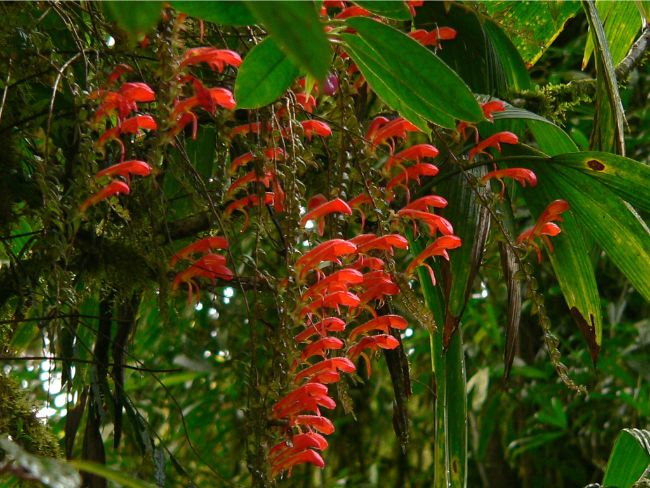
Fertilizing Goldfish Plants
Goldfish plants need regular feeding during the growing season to maximize their blooms, but they take it in best through their leaves instead of their roots.
They prefer a water-soluble fertilizer with extra phosphate (the middle N-P-K number). Mixes like 10-30-10 or 10-54-10 are suitable; they should have micronutrients, too.
Prepare a very weak solution in conditioned, filtered water (or rainwater), using a fourth the amount suggested on the label. Mist the plant with the solution every two weeks during the growing season. Again, avoid putting it in the potting soil as it can burn their little roots.
Reduce fertilization in the fall and hold off over the winter or during dormancy.
Humidity
The humidity factor is probably why some people call Goldfish plants prolific bloomers and others never see a flower. Humid areas like Florida and the coast naturally have the right conditions for this moisture-loving plant. The rest of us have to work at it.
There are four basic strategies to provide higher humidity in arid homes:
- Grouping plants – This can be a great solution for tabletop specimens, but hanging plants may not be helped as much. Water vapor may not rise high enough to reach them, so a floor-level homemade jungle can be ineffective.
- Pebble-filled Trays – Again we encounter an elevation challenge: Goldfish plants in hanging baskets don’t easily benefit from a land-based water tray. You might try one of the hanging basket bottoms meant to prevent drips … the water it catches could double as a humidity-booster. It’s seldom mentioned but worth a try.
- Humidifier – The surest method is to get a humidifier for the area. This does bring a new set of chores, but it will help all your plants; You may need an enclosed area to keep vapor from seeping away instead of rising to envelop your hanging specimen. Don’t aim the humid exhaust at the plant directly: a wet draft does more harm than good.
- Daily Misting – Misting isn’t always effective, but it benefits Columneas more than most houseplants. Since they take in plenty of moisture from their leaves, it gives them a sip of moisture as it briefly humidifies the ambient air.
There are warnings about avoiding water on their leaves, but if you use a fine spray and room temperature water it shouldn’t cause problems. Big water drops that sit in the sun are really the issue. Nurseries carry the atomizing misters you need.
Read more about creating perfect humidity conditions for your houseplants here.
Flowering
There are many varieties to choose from. The blooms come in varying shapes – some longer, some fatter. They can look more or less like actual goldfish, but all their flowers are rich shades of yellow, orange or red. Some bloom throughout the season; others have dormant phases. A few have variegated foliage.
These personable flowers don’t require prompting: with the right light and moisture, they bloom throughout the warm season. Routine high-phosphate fertilization supports an abundance of blooms.
After flowering, some Columneas produce odd little white balls as the inedible fruit of their labors. You can leave them on the plant until pruning time.
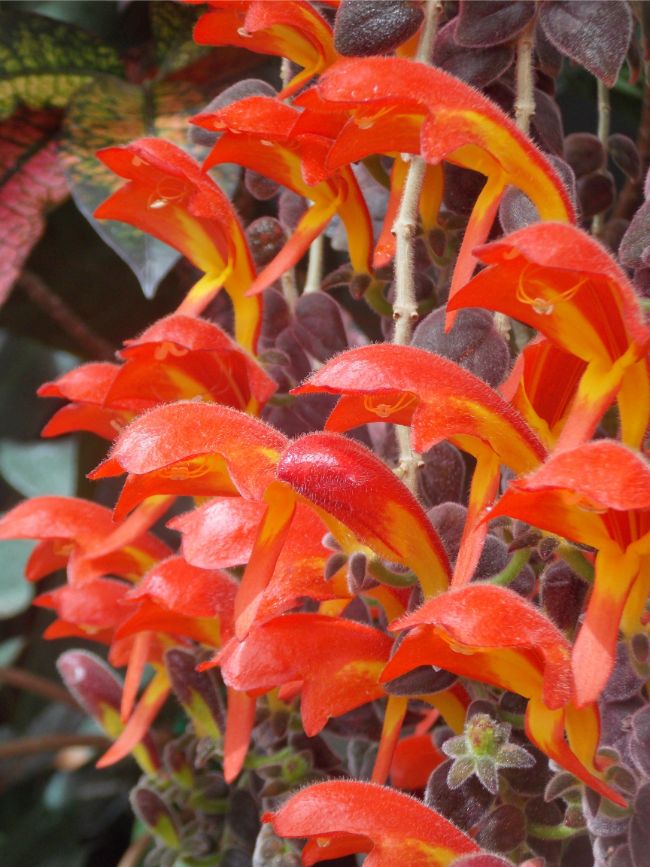
Dormancy
Many Columnea gloriosa varieties go dormant periodically. This can cause owner panic and excessive attention, but is a normal part of goldfish plant care.
If your plant looks healthy but starts dropping leaves, simply reduce watering and stop fertilizing. Dormancy lasts from a month to six weeks. When you see new growth, resume normal care.
Goldfish Plant Pruning
Goldfish plants tend to get a bit leggy and sparse, and low light increases this tendency. Pinching their tips helps signal the plant to create more stems to give it a bushier look.
Keeping stems from 12 (30cm) to 18 inches (45cm) long helps concentrate the plant’s blooming energy.
The strategy is to let them grow longer and regularly cut them back. Flowers bloom on new growth, so wait until the blossoms fade before pruning. Otherwise, despite otherwise perfect goldfish plant care, you might never see flowers!
Once a stem’s blossoms have died, pinch the stem back halfway or so. This leads to new growth, and next season’s flower show.
Propagation
You can add to your Goldfish plant collection by simple propagation … here’s how:
- Create a planting medium of half perlite and half peat moss.
- Place a small group of two to four inch stem-tip cuttings in the potting mix. Four to ten cuttings makes a nice bowl. Optional: Dab the cut ends with powdered root hormone before planting.
- Place the pot in a plastic bag and give it ample bright light.
- Mist occasionally to keep them moist. It takes about a month for roots to grow and begin anchoring.
The best time to root your cuttings is in the spring or summer. They can begin blooming the following year.
Planting Tips
A shallow “azalea” pot is best, because it doesn’t leave empty anaerobic space beneath the Columnea’s small rootball.
Make sure their pot has drainage holes so water doesn’t pool at the bottom. An interior layer of pebbles doesn’t suffice. If your chosen pot lacks drainage, use it as an outer pot for a regular nursery container with appropriate holes.
This plant likes a lot of air around its roots, so don’t pack down the planting medium. Firm it only enough that the plant stands up.
Re-Potting A Goldfish Plant
Columneas like being rootbound, so you’ll only need to repot every two or three years. It also likes tight quarters: even if it’s grown since last repotting, only go up one size.
Freshen their soil by washing the roots gently in room-temperature, conditioned water.
Trim the roots slightly. Use sterile blades and cut as much as the bottom third of the rootball: this encourages new growth into the fresh medium.
Diseases And Pests
The high humidity these plants like increases the risk of fungus and mold issues. The tender foliage of Goldfish plants are also susceptible to aphids, mealy bugs, and scale infestations.
Prevention is best. Maintaining good air circulation and letting the top two inches of the potting mix dry before rewatering minimizes problems with goldfish plant care. A weekly shower can guard against insect infestations, but wait until their medium is dry.
The second best defense is early detection, so regularly inspect the leaves and stems.
Common Goldfish Plant Care Questions
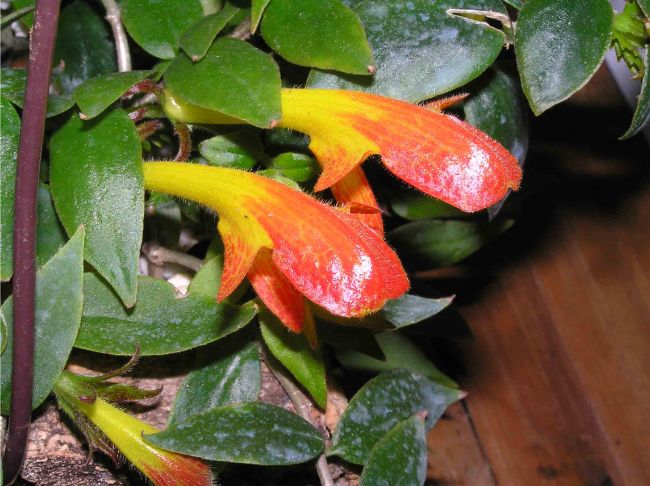
Why Is My Columnea Losing Leaves? It Gets Plenty Of Light!
The plant may be entering dormancy, so cut back on watering and watch it carefully; start back when you see growth.
Heat will also cause leaf drop. If you’re seeing some browning, this is a likely cause. Remember that temperatures are higher near the ceiling, so a hanging plant may be warmer than you realize.
Why Is My Goldfish Plant Not Blooming?
The #1 reason for poor blooming is light that isn’t bright enough, or doesn’t give the plant enough hours of exposure. Another hint: their leaves will curl if the light is insufficient.
Give them at least 12 hours of bright indirect light a day. You can supplement with artificial lighting.
Low humidity can be a factor. Also, make sure you’re fertilizing regularly, but lightly, with a phosphorous-rich fertilizer.
Finally, overzealous pruning can eliminate the new growth that forms buds. Wait until after flowering season before cutting back.
Are Goldfish Plants Toxic?
Columnea gloriosas have a Level 1 toxicity, the lowest rating considered poisonous.
They can cause mild to more serious irritation if ingested, so they should be kept away from pets and children. It’s another reason they make great hanging plants.

